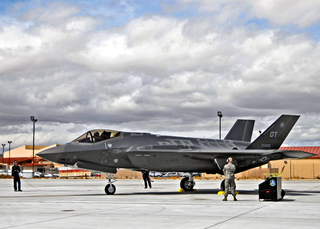The Army Air Forces Tactical Center was a major command and military training organization of the United States Army Air Forces during World War II. It trained cadres from newly formed units in combat operations under simulated field conditions around which new combat groups would be formed. It was established as the Army Air Forces School of Applied Tactics (AAFSAT) in 1942 and redesignated the following year.

15th Attack Squadron is a United States Air Force unit assigned to the 432d Wing, 732nd Operations Group at Creech Air Force Base near Indian Springs, Nevada. It flies the General Atomics MQ-9 Reaper remotely piloted aircraft.

The 53d Wing is a wing of the United States Air Force based at Eglin Air Force Base, Florida. The wing reports to the United States Air Force Warfare Center at Nellis Air Force Base, Nevada, which in turn reports to Headquarters Air Combat Command.

The 75th Air Base Wing is a wing of the United States Air Force based out of Hill Air Force Base, Ogden Utah. It provides base operating support for the Ogden Air Logistics Complex, the 388th, 419th Fighter Wing, 84th Combat Sustainment Wing, 309th Maintenance Wing, 526th ICBM Systems Wing, 508th Aircraft Sustainment Wing and 25 associate units.

The 76th Tactical Reconnaissance Group is a disbanded United States Army Air Forces organization. It was last active in 1944 as part of the Desert Training Center at Thermal Army Air Field, California.

The 127th Command and Control Squadron was a unit of the Kansas Air National Guard 184th Intelligence Wing stationed at McConnell Air Force Base, Wichita, Kansas. The 127th was a non-flying squadron operating the Distributed Common Ground System. The unit was inactivated on 29 September 2014.

The 69th Reconnaissance Group is an inactive United States Air Force that was part of Air Combat Command, the group was stationed at Grand Forks Air Force Base, North Dakota where it was a tenant of the 319th Air Base Wing.

The 4th Reconnaissance Squadron is an active United States Air Force unit, assigned to the 319th Operations Group and stationed at Andersen Air Force Base, Guam, from which it operates RQ-4 Global Hawk unmanned vehicles. It was activated there in July 2020.

The 44th Reconnaissance Squadron is a unit of the United States Air Force 432d Wing, Air Combat Command stationed at Creech Air Force Base, Nevada, where it operates unmanned aerial vehicles. The squadron is assigned to the 732d Operations Group, and has been reported to operate the Lockheed Martin RQ-170 Sentinel.

The III Reconnaissance Command was a United States Army Air Forces unit. Its last assignment was with Third Air Force stationed at Rapid City Army Air Base, South Dakota, where it was inactivated on 8 April 1946.

The III Tactical Air Command was a United States Army Air Forces formation. Its last assignment was with Third Air Force stationed at Barksdale Field, Louisiana. It was disbanded on 24 October 1945. The command was established in 1941 as the 3rd Air Support Command. It was responsible for training tactical units and aircrews for the Army Air Forces, except for the period from August 1943 through March 1944, when it specialied in training reconnaissance units.
The 74th Reconnaissance Group is an inactive United States Air Force unit. It was last assigned to the 91st Air Division at Stewart AFB, New York.
The II Air Support Command is an inactive United States Air Force unit. It was last assigned to Third Air Force at Biggs Field, Texas, as the II Tactical Air Division, where it was inactivated on 22 December 1945.

The I Tactical Air Division is an inactive United States Air Force unit. It was last assigned to Second Air Force, based at Biggs Field, Texas. It was inactivated on 22 December 1945.

The 56th Training Squadron is an active United States Air Force unit. It is assigned to the 56th Operations Group at Luke Air Force Base, Arizona.

The Second Bombardment Wing, abbreviated both as 2d Bombardment Wing and 2nd Bombardment Wing, of the United States Army Air Forces is a disbanded unit whose last assignment was with the Continental Air Forces, based at McChord Field, Washington. It was last active in November 1945.

The United States Air Force's 97th Intelligence Squadron is an intelligence unit located at Offutt Air Force Base, Nebraska.

The 3d Special Operations Squadron flies MQ-1 Predator Remotely Piloted Aircraft and is currently located at Cannon Air Force Base, New Mexico. The squadron is under the command of the Air Force Special Operations Command.

The 29th Attack Squadron is a remotely piloted vehicle training unit of the United States Air Force. Assigned to the 49th Operations Group, 49th Wing at Holloman Air Force Base, New Mexico. Flying the General Atomics MQ-9 Reaper. It was activated on 23 October 2009.

The 65th Military Airlift Support Group is an inactive unit of the United States Air Force. It was last active as part of Military Airlift Command at Yokota Air Base, Japan, where it was inactivated on 1 June 1972.



















